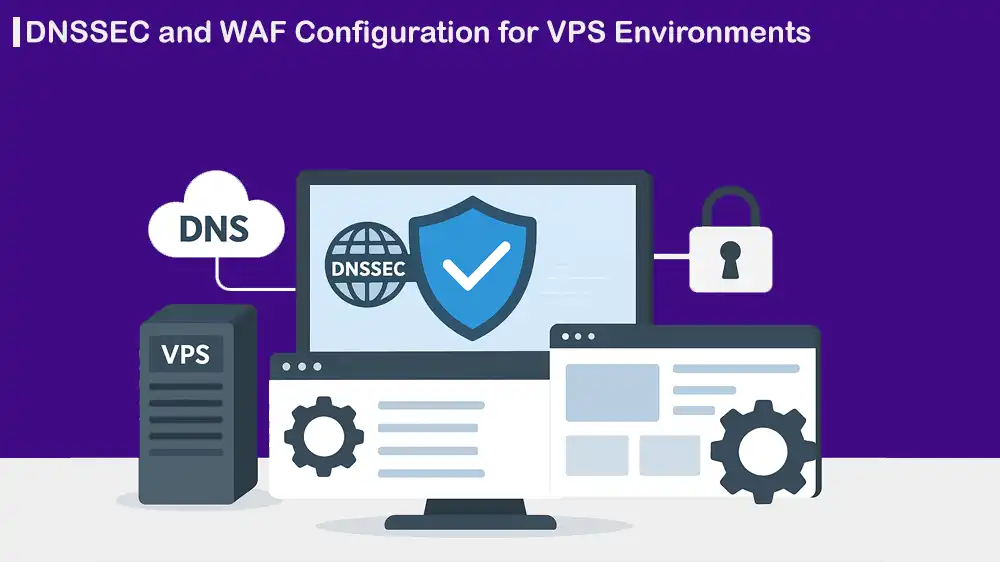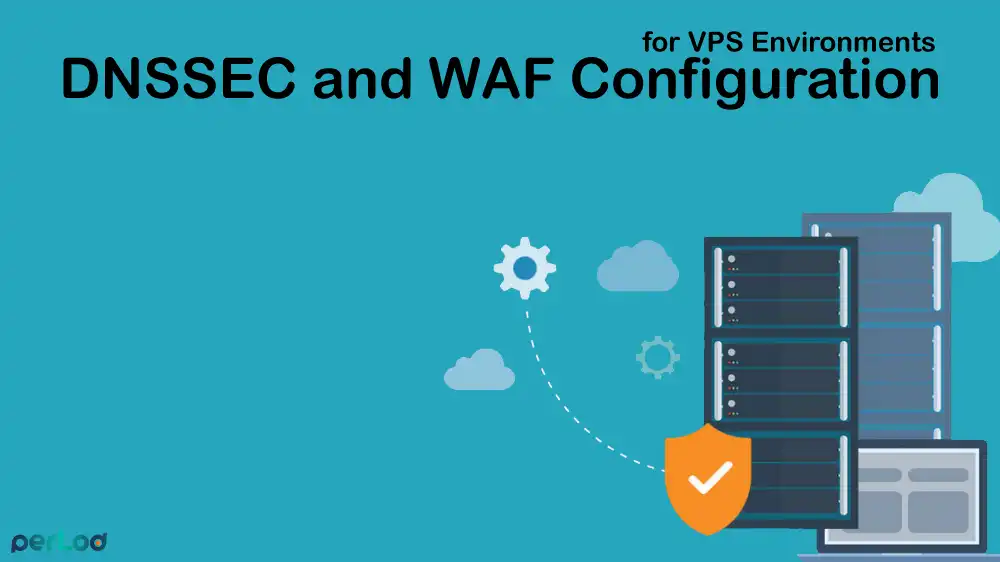
DNSSEC WAF VPS Configuration
In today’s Tech world, hackers and cyber threats are getting smarter. If your website is not protected, it can easily become a target for hackers. That’s where DNSSEC WAF VPS Configuration comes in. These tools make sure your website runs smoothly, securely, and with high performance.
In this guide, we will explain what DNSSEC is, how WAF benefits your VPS, and provide a step-by-step configuration process to help you secure your hosting environment. We’ll also cover testing, validation, key management, and monitoring best practices.
If you’re hosting with PerLod, this guide will make your setup even easier.
Table of Contents
What is DNSSEC and Why Does it Matter?
Domain Name System Security Extensions (DNSSEC) is an extra layer of security that adds to the Domain Name System (DNS). As you must know, DNS translates domain names like perlod.com into IP addresses so browsers can load websites.
DNS by itself is not secure; it can be hacked through attacks. By using DNSSEC, you can prevent cybercriminals from redirecting traffic to malicious websites.
With DNSSEC, here is what happens:
- Each DNS record is digitally signed.
- Signatures are verified to make sure data hasn’t been altered.
- Visitors are guaranteed to connect to the right website, not a fake one.
DNSSEC matters for businesses because it protects users from phishing attacks, prevents DNS hijacking, builds trust and credibility, and works with SSL certificates for full security.
If you’re running your website with PerLod VPS hosting, enabling DNSSEC is a smart move to keep your visitors safe.
Benefits of WAF in VPS
WAF is a web application firewall that acts as a security guard for your website. It filters, monitors, and blocks harmful traffic before it reaches your VPS.
Key Benefits of WAF on VPS:
- Protection from Attacks: It stops SQL injections, XSS, DDoS, and other common threats.
- Improved Performance: It speeds up your site’s performance by filtering bad traffic.
- Compliance Support: Helps meet data protection requirements like PCI-DSS.
- Easy Integration: It can be integrated with hosting panels like cPanel, Plesk, and PerLod’s custom VPS solutions.
- Monitoring: It constantly monitors incoming traffic and keeps hackers out.
Now that you have understood DNSSEC and WAF, let’s start the configuration process with DNSSEC and WAF on the VPS.
Step-by-Step DNSSEC WAF VPS Configuration Process
At this point, we will go for a step-by-step DNSSEC and WAF setup for VPS.

1. Enable DNSSEC for the Domain
First, you must log in to your domain registrar, like PerLod Domain Registration.
Then, find the DNSSEC settings and generate DNSSEC keys (ZSK and KSK).
- KSK (Key Signing Key): signs other keys.
- ZSK (Zone Signing Key): signs DNS records.
After generating the keys, your registrar will ask you to add a DS (Delegation Signer) record. This record tells the internet that your domain is protected with DNSSEC. Once you are done, save changes.
Tip: If you’re using PerLod hosting, the control panel provides simple tools to enable DNSSEC without manual key generation.
2. Install a WAF on VPS
At this step, you must choose a WAF like ModSecurity, Cloudflare WAF, or PerLod’s built-in WAF options.
Then, install it on your VPS and configure filtering rules to block suspicious traffic.
3. Configure Firewall Rules and Secure VPS Settings
Also, you must block unwanted IP addresses through your firewall and limit login attempts so attackers can’t try many passwords. You can prevent DDoS attacks by enabling rate limits, which stop too many requests from the same source.
To keep your server secure, always keep your VPS updated, and use SSH keys instead of passwords. This makes it much harder for hackers to guess your login.
Back up your server regularly so you can restore your website if something goes wrong.
4. DNSSEC WAF Testing and Validation
After the DNSSEC WAF VPS Configuration, it is important to test your configuration. Here is what you must do after setup:
- DNSSEC Validation: You can use online tools to check if DNSSEC is working.
- WAF Testing: Also, you can test your WAF by simulating attacks using penetration testing tools. Check if malicious requests are blocked.
- VPS Security Scan: Be sure to run server scans to detect vulnerabilities.
Tip: PerLod customers can use the built-in monitoring tools to quickly validate DNSSEC and WAF configurations.
Tips For DNSSEC Key Generation and Management
DNSSEC works with cryptographic keys to make sure DNS records are safe:
- KSK (Key Signing Key): Used to sign the ZSK and prove that the DNS records are valid.
- ZSK (Zone Signing Key): Used to sign the actual DNS records (like A, MX, TXT).
Best practices for DNSSEC cryptographic keys:
- Rotate keys regularly so attackers cannot reuse old ones.
- Store keys in a safe place. Don’t keep them in public folders or shared locations.
- Automate key rollover. Many hosting providers offer this to reduce manual work
Tip: If you’re using PerLod hosting, you don’t need to worry about manual key management. The VPS panel handles key generation and rotation for you.
DNSSEC and WAF Integration with Hosting Control Panels
Manually managing DNSSEC and WAF can be complex. But most control panels like cPanel and Plesk, support both DNSSEC and a common WAF.
Also, you can use your hosting provider’s control panel, like PerLod, which is easier to use and lets you enable DNSSEC and configure WAF in just a few clicks, without needing deep technical knowledge.
Tips for Setting WAF Rules and Policies
To have a powerful WAF, you must configure it properly.
Consider block common threats such as SQL injections, XSS attacks, and brute-force login attempts. Modify custom rules for your site’s needs. Whitelist trusted IPs so your own team or partners aren’t blocked. Also, you can perform geo-blocking, which helps to reduce risks by blocking traffic from high-attack regions.
Tip: On PerLod VPS hosting, you will get pre-configured WAF rules to protect your website, and you can also customize them if you need special settings.
Best Practices for Ongoing VPS Security
Here are the best tips for ongoing security:
- Monitor logs to see who is trying to access your server.
- Enable real-time alerts so you know immediately if something suspicious happens.
- Check DNSSEC signatures to make sure they are valid and not expired.
- Review WAF reports for blocked attacks.
- Run regular VPS security audits to find weak spots.
PerLod provides 24/7 monitoring for VPS hosting, so you can focus on your business while the system watches for threats.
FAQs
Why do I need a WAF on my VPS?
A WAF protects your website from common attacks and ensures only safe traffic reaches your server.
Can I set up DNSSEC and WAF without technical knowledge?
Yes, if you use a hosting provider like PerLod, it offers simplified tools and automated security features.
How do I test if DNSSEC is working?
You can use online tools like DNSViz, Verisign Labs, or your hosting panel’s validation tool.
Final Words
By setting up DNSSEC WAF VPS Configuration, you protect your visitors, improve your site’s performance, and build trust. While the process may seem complex, with the right hosting provider like PerLod, it becomes much easier. From key generation and management to rule setting and monitoring, PerLod helps you secure your VPS hosting environment with ease.
We hope you enjoy this article. Subscribe to our X and Facebook channels to get the latest updates and articles.
For further reading:
